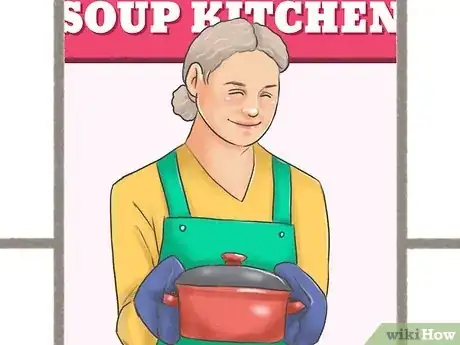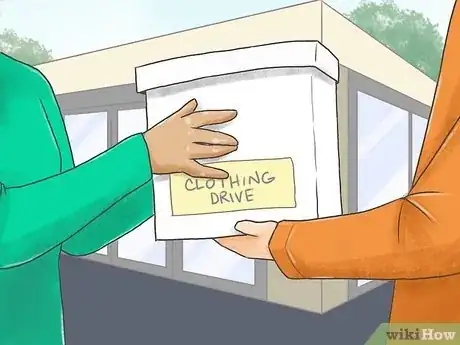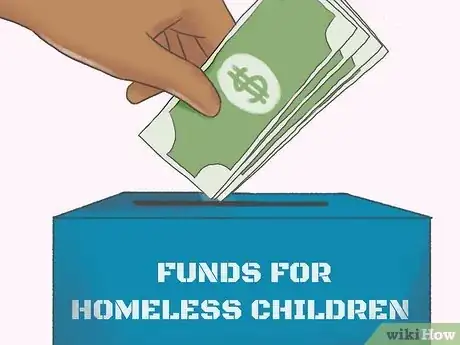This article was co-authored by Dan Bodner. Dan Bodner is a Transitional Shelter & Homelessness Expert and the CEO & Founder of QuickHaven Transitional Shelters. With over 20 years of experience, he specializes in executive leadership, product development, and innovation, which have helped him develop modular tiny homes to improve the lives of those affected by homelessness. Dan earned a BA from Vassar College and an MS from the University of Texas at Austin.
There are 7 references cited in this article, which can be found at the bottom of the page.
This article has been viewed 32,069 times.
Overcoming homelessness is one of the great challenges you will face as a member of a responsible society. Children under the age of 18 are particularly vulnerable to the effects of poverty, homelessness, and abuse. By learning how to volunteer your time and money, and educating yourself about the struggles of homelessness, you can make a positive impact on your community and improve the lives of homeless children.
Steps
Educating Yourself and Others
-
1Do your research. One of the first steps to empathizing with homeless children is learning about the events surrounding their circumstances. Some children leave home after being repeatedly abused, others have multiple family members that are also homeless. Many homeless youth have already begun using or selling drugs as a means of coping with their situation. Read up on the facts about youth homelessness so you can be better prepared to help.[1]
- Most shelters or kitchens that deal with homeless youth will have informational pamphlets available. Reputable organizations like the National Coalition for the Homeless also feature valuable information on their websites.[2]
-
2Become an advocate. Find out what resources are needed at homeless shelters or soup kitchens and contact local charities or civic organizations to sponsor food or clothing drives. You can also be an effective advocate for homeless youth by attending city councils and county supervisor meetings and speaking up about how the city could better allocate resources to help them.[3]
- A major part of advocating for the homeless is using respectful terminology. Instead of “street kid” or “vagrant,” use phrases like “children experiencing homelessness.”[4]
Advertisement -
3Fight stigma. Many people are discouraged from helping homeless youth and families due to unfair and inaccurate information about homelessness. Use what you've learned to encourage others to rethink their biases when it comes to homeless youth.
- If a colleague makes a generalization like, "All homeless people are lazy," you might counter with "A lot of homeless youth don't have the resources to help themselves, and others have substance abuse problems or emotional health concerns."[5]
- Almost 40 percent of homeless youth identify as LGBTQ—others constitute racial minorities. Being sensitive and informed about the special challenges facing minority homeless youth can help you better serve them.
-
4Spread the knowledge yourself. Use what you have learned to influence the way others think about homeless children. Start by striking up casual conversations with friends, loved ones, or coworkers to share information. As you become more confident addressing these topics, consider hosting an informative session at your home, local recreation center, or place of worship.
- Consider inviting the director of a homeless youth center to come speak at your workplace or a community center. Ask them to hold a Q and A session to address the challenges facing homeless children.
- If you decide to host an informative gathering, consider inviting a young person who has experienced homelessness to speak about their experiences and educate the audience about how to be sensitive to the needs of homeless youth.
-
5Direct your friends or colleagues to useful information. Organizations like the National Alliance to End Homelessness often host conferences to keep communities informed and engaged. Others, like the NCH, maintain facts sheets on their websites designed to educate people about the causes of youth homelessness as well as keep them updated on statistics and special issues.[6]
- No matter how passionately you may feel about circulating information on youth homelessness, try your best to be tactful and sensitive about it. Friends and coworkers may respond better to the occasional email or brochure than a constant inundation of suggestions and statistics.
-
6Encourage others to participate. Go the extra mile by suggesting that your friends or family attend advocacy events or informational meetings with you. Be on the lookout for outreach programs or conferences in local newspapers or online forums.
- Undertaking short fasts, such as skipping one meal in a day, can cause people to stop and think about what life is like for children who are hungry on a regular basis. Experiences like these can often teach more effectively than a conference or brochure.
Volunteering Your Time
-
1Volunteer at a homeless shelter. Homeless shelters and soup kitchens need lots of help. This can mean doing anything from clerical work like filing papers and answering phones to dealing directly with the children at the shelter. Whether you're washing dishes, folding clothes, or serving a meal, donating your time at a shelter will positively impact the lives of homeless youth, and enrich your life as well.
- Working with homeless children directly usually requires that you be at least 18 years of age and pass a background check. If you're planning on volunteering at a homeless shelter, be prepared to meet these criteria.
-
2Make use of your skills. If you have any legal, secretarial, medical, counseling, plumbing, carpentry, or other occupational skills, put them to use for a shelter or soup kitchen. Volunteer your services at your local shelter or offer to train others.
-
3Get others involved. Invite a friend or colleague to volunteer with you at a homeless shelter or ask them to participate in a food or clothing drive. They may soon find they have as much of a passion for helping homeless youth as you do!
- When recruiting others to donate their time or resources, be respectful of their boundaries. Not everyone is comfortable spending long periods of time at shelters or offering up their professional skills, so don't demand that they do so right away.
Donating to Charitable Organizations
-
1Choose a reputable charity. There are many charities that assist homeless youth, but it's important to find one that allocates its resources well and steers clear of political posturing or financial corruption. Research the charitable institution you plan on patronizing to make sure they have the best interests of homeless youth at the heart of everything they do.[7]
- Well known organizations like Stand Up For Kids, Habitat for Humanity, or Housing Families have the experience needed to effectively make use of their donations. When in doubt, donate to a well respected institution.
- Many charities offer the opportunity to sponsor a child. This method of donation can be particularly helpful as it allows a child the benefit of one patron they can look up to. Research sponsorship to see if it's right for you.
-
2Give within your means. Not everyone can afford to write big checks to charities. Sometimes all it takes to make a difference is donating a few dollars a month or collecting canned goods to take to a food bank. There's nothing wrong with giving generously, but make sure you're staying with your own means and being financially responsible.
- Another great way to give to homeless children is by donating clothes, diapers, shoes, and hygiene items. Donate hand-me-downs to a clothing drive or make a gift of new toothbrushes to a homeless youth center to increase a charity's resources and their potential to help homeless children.
-
3Be consistent. Whatever method of donation you choose, it's important to be consistent in your support. Make regular, incremental donations to a charity and you'll begin to see the improvements brought about by your support.
Community Q&A
-
QuestionHow would I go about giving a homeless child in my school a place to stay with me?
 Community AnswerStart by talking to your parents about the child. They will be able to figure out all of the details about potentially letting the child stay with you.
Community AnswerStart by talking to your parents about the child. They will be able to figure out all of the details about potentially letting the child stay with you. -
QuestionWhat if I want to volunteer but I'm under 18?
 SapphiaCommunity AnswerDifferent volunteer places have different rules. Some accept teenage volunteers, but you may need to be accompanied by a parent. It is best to check the organization's website or call them.
SapphiaCommunity AnswerDifferent volunteer places have different rules. Some accept teenage volunteers, but you may need to be accompanied by a parent. It is best to check the organization's website or call them. -
QuestionI am volunteering over New Year at a temporary shelter for families. I want to make it really special for the kids, but don't have too much money to invest. Any ideas?
 Community AnswerYou could buy some books from the second hand store and read with them. Or, get some art books and pencils for coloring and drawing.
Community AnswerYou could buy some books from the second hand store and read with them. Or, get some art books and pencils for coloring and drawing.
Warnings
- It's better to approach homeless children in the company of a group or person they've come to trust. Many homeless children are on the lookout for predatory or punitive adults and they will avoid strangers.⧼thumbs_response⧽
References
- ↑ https://www.dosomething.org/us/facts/11-facts-about-homeless-teens
- ↑ http://nationalhomeless.org/issues/youth/
- ↑ http://www.mnn.com/lifestyle/responsible-living/blogs/9-ways-you-can-help-the-homeless
- ↑ http://nationalhomeless.org/want_to_help/
- ↑ https://www.nn4youth.org/wp-content/uploads/IssueBrief_Education.pdf
- ↑ http://nationalhomeless.org/factsheets/index.html
- ↑ http://www.endhomelessness.org/pages/donate1









































































